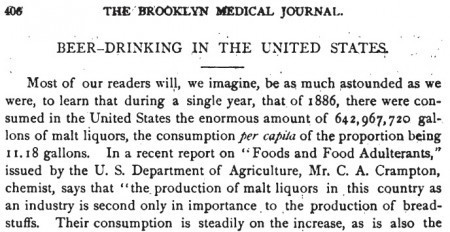Marc Abrahams's Blog, page 432
January 16, 2014
The Nose, Cold Feet, “Tobacco” Heart, and Convallaria Majalis
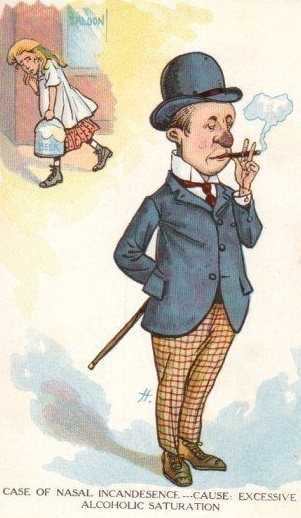 One of 1900′s top contenders for “Article Title of the Year”, in the medical category, must have been The Nose, Cold Feet, “Tobacco” Heart, and Convallaria Majalis, by H.S. Purdon of the Belfast Hospital for Skin Diseases. Published in the Dublin Journal of Medical Science (August 1900), vol. CXX, pp. 110-112, the title may sound like one of those colorful novels about the quirky inhabitants of a small Southern town, but it’s actually a discussion of the side effects of smoking.
One of 1900′s top contenders for “Article Title of the Year”, in the medical category, must have been The Nose, Cold Feet, “Tobacco” Heart, and Convallaria Majalis, by H.S. Purdon of the Belfast Hospital for Skin Diseases. Published in the Dublin Journal of Medical Science (August 1900), vol. CXX, pp. 110-112, the title may sound like one of those colorful novels about the quirky inhabitants of a small Southern town, but it’s actually a discussion of the side effects of smoking.
The injurious effects of the excessive use of tobacco — both smoking and “chewing” — on the general state of health is well known. There are, however, two symptoms connected with the weakened heart and “soft” pulse, viz.– a congested or dusky red color of skin of nose, generally cold to the touch; and also, especially in winter, cold feet; in other words, a condition due to feeble circulation.
Circulatory feebleness is a worry for sedentary cigar or pipe smokers, whether elderly, infirm, or simply men of leisure, but is unknown in smokers of vigorous occupation. How to combat this weakness of the heart? Calisthenics, maybe. But what really works for Dr. Purdon is the extracts of the wildflower called lily of the valley (Convallaria majalis), noted for the elegant drooping of its flowers, its persistence in European myth and legend, and its intense toxicity.
Gerrard, the herbalist and surgeon, A.D. 1570, gives the following curious formula, and which, as well as the subsequent quotation, is interesting in a historical point of view — “The flower being close stopped up in a glass, put into an ant-hill, and taken away again a month after, ye shall find a liquor in the glass which being continually applied helps the gout.” Old Nicholas Culpeper, Surgeon Apothecary, writing in A.D. 1630, remarks in his “Complete Herbalist” — “The spirit of the flowers distilled with wine, restores lost speech, helps the palsy, comforts the heart and vital spirits.”
Purdon also cites a couple more recent endorsements.
But what if you think your heart is fine, or at least that you wouldn’t benefit from ill-defined plant extracts intended to strengthen your cardiac contractions? All you want, to be honest, is to get your nose looking like a nose again instead of a stoplight. Well, that can be arranged.
[F]or the cold feet and in all cases of any redness of the nose, especially in those of the female sex, no matter how caused, a mustard foot bath at night for ten to fifteen minutes, followed by brisk friction, and in winter a “hot jar” in bed is most useful as well as comforting. For the local treatment of redness of nose a sulphur and calamine lotion rubbed into that organ stimulates the skin circulation and does good in restoring a natural appearance to that prominent and important organ.

If nose redness advances this far, it may be incurable.
Unlike most prescriptions of 1900, sulfur and calamine lotion is still used for skin conditions. But now, a sulfur-based acne medication can be marketed as “Pure & Clear”, “holistic” and “gentle”. Lily of the valley is no longer used in mainstream medicine; though to be a herbal remedy, medical references only mention it as a source of poisoning.
As for the “hot jar”, we’re not sure what it is, but it should be applied to the feet.
Follow Amboceptor on Twitter: @AmboceptorBlog

January 15, 2014
The taste of electric currents (part 1 of 2)
It was sometime around 1752 that Johann Georg Sulzer decided (for reasons best known to himself) to put the tip of his tongue between two plates of (different) metal whose edges were in contact. The results were, quite literally, shocking. He’d not only inadvertently stumbled across one of the world’s first electrolytic batteries, but it was also completing a circuit via his tongue. With unignorable results. As if this wasn’t enough, at the same time he’d also experienced what was very probably the first instance of electro-gustation (electrically induced phantom flavour perception). “A pungent sensation, reminds me of the taste of green vitriol when I placed my tongue between these metals.” [was his alleged remark]
In the intervening 260+ years since then, research groups across the globe have made great strides in the field of electrically induced taste-sensations. Take for example the work of the Miyashita Laboratory at Meiji University, Tokyo, Japan. Where Hiromi Nakamura, along with Professor Homei Miyashita himself have been developing the idea of what they call ‘Augmented Gustation’.  A paper from the authors, entitled ‘Augmented Gustation using Electricity’ was presented at the 2nd Augmented Human International Conference – AH’11 The team not only designed and tested the world’s first taste enhancing electric chopsticks (pictured), but also investigated a form of ‘taste communication’ between two (mildly) electrified people who complete a circuit by joining hands whilst drinking from a specially constructed electric cup. “The goal of our system – ” say the team “- is to obtain a new layer of tongue that can detect tastes that we could not perceive previously.“
A paper from the authors, entitled ‘Augmented Gustation using Electricity’ was presented at the 2nd Augmented Human International Conference – AH’11 The team not only designed and tested the world’s first taste enhancing electric chopsticks (pictured), but also investigated a form of ‘taste communication’ between two (mildly) electrified people who complete a circuit by joining hands whilst drinking from a specially constructed electric cup. “The goal of our system – ” say the team “- is to obtain a new layer of tongue that can detect tastes that we could not perceive previously.“
Also see (taste related) : Tastes like Trombones and A Taste of Protons

January 14, 2014
A technological way to create temporary images in/on a head of hair
Everyone with a head of hair—not just the members of the Luxuriant Flowing Hair Club for Scientists (LFHCfS)—is likely to be intrigued by this new patent for creating images in/on a head of hair. Think of the images as nano-patterned temporary tattoos, if you like:
“Hair treatment process providing dispersed colors by light diffraction,” US patent # US8607803, granted December 17, 2013 to Bruce Carvell Lamartine, E. Bruce Orler, Richard Matthew Charles Sutton, Shuangqi Song. The patent document explains:
“The nano-patterned block can be incorporated into a hand held device similar to a common hair flatiron. A nano-patterned block may be suitably configured to provide a nano structured pattern in film coated hair to produce a rainbow of colors. A nano-patterned block can also be suitably configured to produce directionally specific images in the polymer coated hair. The net effect of applying the method to hair is that When the hair changes position relative to a dominant light source, such as sunlight or theatrical lights, the hair color and any images incorporated into the hair change as well. Different nano-patterned blocks may be used for different multiple color or image effects in the treated hair.”
Here’s detail from the patent:
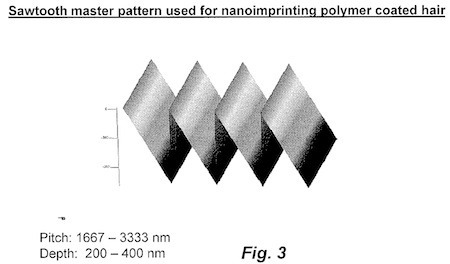
The Albuquerque Journal reports:
LANL is not just nukes – lab gets temporary hair patent
There’s no telling what hair trends will be in the future, but if one day you see someone with the Declaration of Independence etched into their locks, it’s a pretty good bet that scientists at Los Alamos National Laboratory had something to do with it. Product developers at LANL and Proctor and Gamble were recently awarded a U.S. Patent for a hair treatment process that would potentially allow someone to exhibit just about any image they want in their hair through light diffraction.
“Imagine a temporary tattoo for hair – that’s essentially what this is,” said Steve Stringer, a LANL employee who serves as industrial fellow to P&G. Stringer said the patented process involves cutting a nanopattern into the hair that diffracts incident light and disperses colors. The process itself requires no colorization, but is a natural occurrence. “If you look at a parrot or a butterfly and see brilliant colors, you’re not looking at pigment, you’re looking at light diffraction,” Springer said. “It’s not pigment, it’s not paint, it’s actually sunlight that’s being spread by diffraction….
(Thanks to investigator Gopinath Subramanian for bringing this to our attention.)

Bee’s Treefrogs In an Assault on the Cocktail Party Problem
Treefrogs often find themselves faced with the Cocktail Party Problem. Those who study the Cocktail Party Problem have their own complicated mess to make sense of: They try to understand how someone amidst a yacketing group can understand one particular conversation even though many other conversations are equally audible.
This study sees treefrogs as possibly being or supplying keys to understanding understanding in cocktail party situations:
“Treefrogs as Animal Models for Research on Auditory Scene Analysis and the Cocktail Party Problem,” Mark A. Bee, International Journal of Psychophysiology, epub January 11 2014. The author, at the University of Minnesota, reports:
“Here, I review recent and ongoing work aimed at testing hypotheses about perceptual mechanisms that enable treefrogs in the genus Hyla to communicate vocally in noisy, multi-source social environments. After briefly introducing the genus and the methods used to study hearing in frogs, I outline several functional constraints on communication posed by the acoustic environment of breeding ‘choruses’. Then, I review studies of sound source perception aimed at uncovering how treefrog listeners may be adapted to cope with these constraints. Specifically, this review covers research on the acoustic cues used in sequential and simultaneous auditory grouping, spatial release from masking, and dip listening.”
Here’s video, from Professor Bee, of Cope’s gray treefrog in something of a cocktail party situation:
(Thanks to investigator Neil Martin for bringing this to our attention.)

Unanticipated use and value of cigarettes: Endurance training
Cigarettes are useful for different purposes. Perhaps the best purpose is suggested in this study:
“Cigarettes may be useful for distance runners?!? (or, How to prove anything with a review article),”
Last winter the Canadian Medical Association Journal published a fascinating article by Ken Myers discussing the (as-yet unexamined) benefits of cigarette smoking on endurance running performance. Ken is a friend and elite distance runner (we used to literally run with the same crowd while I was doing my undergrad in Calgary) so I was very excited and a bit confused when I saw his article. Could smoking really be beneficial for distance runners like myself? … the point of Ken’s article was to illustrate how you can fashion a review article to support almost any crazy theory if you’re willing to cherry-pick the right data.
Myers’s monograph is:
“Cigarette smoking: an underused tool in high-performance endurance training,” Kenneth A. Myers, Canadian Medical Association Journal, 2010 December 14; 182(18): E867–E869. The abstract says:
The review paper is a staple of medical literature and, when well executed by an expert in the field, can provide a summary of literature that generates useful recommendations and new conceptualizations of a topic. However, if research results are selectively chosen, a review has the potential to create a convincing argument for a faulty hypothesis. Improper correlation or extrapolation of data can result in dangerously flawed conclusions. The following paper seeks to illustrate this point, using existing research to argue the hypothesis that cigarette smoking enhances endurance performance and should be incorporated into high-level training programs.
(HT Deborah Blum)

January 13, 2014
Introducing ‘Critical Studies in Men’s Fashion’
“Men’s dress and fashion have been side-lined in scholarship, and this journal provides a dedicated space for the discussion, analysis, and theoretical development of men’s appearance from multiple disciplines. All articles are blind-peer reviewed in order to maintain the highest standards of scholastic integrity.“
The (new) journal is entitled : ‘Critical Studies in Men’s Fashion’ and the entire inaugural issue is being made free to download in .pdf form. Volume 1, issue 1, has peer-reviewed papers on :
• Peacocks in the sands: Flamboyant men’s beachwear 1920–30
• The hankie code revisited: From function to fashion from which the (unauthenticated) photo above is taken.

January 12, 2014
Another small effect of drinking coffee on some people who don’t regularly drink coffee
Yet another tiny research tentative discovery about possible small biomedical effects of coffee and/or tea:
“Post-study caffeine administration enhances memory consolidation in humans,” Daniel Borota, Elizabeth Murray, Gizem Keceli, Allen Chang, Joseph M Watabe, Maria Ly, John P Toscano and Michael A Yassa [pictured here], Nature Neuroscience, epub 2014. The authors, at Johns Hopkins University and the University of California, Irvine, performed their experiment on 160 people who do not regularly drink much caffeine. They measured long-term effects, where they defined long-term to mean one day. They report:
“Caffeine enhanced performance 24 h after administration according to an inverted U-shaped dose-response curve; this effect was specific to consolidation and not retrieval. We conclude that caffeine enhanced consolidation of long-term memories in humans.”
BBC News interviewed study leader Yassa, who described two highlights of their discovery :
“Our study suggests that 200mg of coffee is beneficial to those who do not regularly ingest caffeine”.
“We also show an inverted U-shape dose response suggesting that higher doses may not be as beneficial”.
Johns Hopkins produced this scholarly cute video to boost awareness of the study:
(Thanks to Roger Highfield for bringing the study to our attention.)
BONUS (unrelated): The Coffee Diet. Below, video of the premiere of the song” The Coffee Diet”, at the 2004 Ig Nobel Prize ceremony:

Improbable Research Returning to Arisia — Saturday, Jan 18
 Improbable Research returns to New England’s largest science fiction and fantasy convention in January, to air interesting research which is neither fiction nor fantasy!
Improbable Research returns to New England’s largest science fiction and fantasy convention in January, to air interesting research which is neither fiction nor fantasy!
We have challenged Arisia’s attendees in past years by showing them diagrams from real patent applications and asked, “What do you think this is? – What do you think this is meant to do?”. And we have tested their appreciation of actual science by reading excerpts from scientific research (for example) on devising parachutes for toxic-laced rodents, on objects doctors have removed from their patients’ recta, on the best way to blow up a dead horse, on UK ostriches directing mating dances toward humans, on how long you need to be infested with ear mites before you regain some of the hearing they at first caused to diminish…
Each year there are new papers, new readers, new ideas… and some returning ones too. Here are some details for attending our session at Arisia 2014:
What: Arisia 2014
Date: Saturday, January 18
Time: 11am EST
Location: Grand Ballroom DE (Westin Boston Waterfront hotel)
Session Name: Improbable Research and the Ig® Nobel Prize
Misc: We will have a limited number of FREE copies of our Magazine available at this event.
Misc: After the event we will make the papers we read (and some that we didn’t) available
Please note: If you are a member of the LFHCfS and plan to attend Arisia, please introduce yourself to us before we start the session and we will help give you all the public admiration your membership deserves
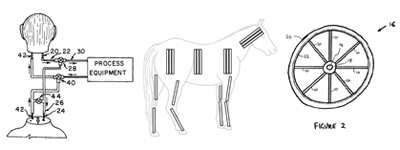
Some of the images we’ve used to challenge Arisia goers

The man who drank enough beer to drown 275 men
This unattributed piece in the Brooklyn Medical Journal (1888) (Volume 1, No. 5, pp. 406-408), reporting on C.A. Crampton’s magisterial USDA report on beer, wine and cider adulterants, contains several odd comparisons.
First we learn that Americans’ consumption of beer has risen tremendously since the Van Buren administration, though it still lags that of competitors.
[I]n 1840 the consumption of malt liquors in the United States was 23,310,843 gallons, or 1.36 gallons per capita, whereas, as has already been stated, nearly twenty-eight times as much was consumed in 1886. It is a matter of interest to know that great as this amount is, it is exceeded by several other nations. In the United Kingdom, 32.79 gallons were consumed in 1886 per capita, and in Germany, 23.78 gallons, while 11.18 gallons represents the per capita consumption in the United States.
Crampton’s original report puts this into context:
[I]n 1840 the amount of malt liquor consumed per capita was a little over one-half the amount of distilled liquor consumed, while in 1886 it was nine times as much. The amount of distilled liquor consumed per capita has diminished during the twenty-six years to one-half, while the amount of malt liquor consumed has increased very nearly seven times; or, in other words, the malt liquors have been driving out the distilled at the rate of about .05 gallons per capita each year, and supplanting it at the rate of about .38 gallons per capita.
The point of all this is that instead of drinking whisky and rum toddies and applejack and blackberry brandy, Americans are drinking beer. But we aren’t getting any drunker, since the extra .38 gallons of beer we’ve been consuming each year should contain about as much alcohol as the .05 gallons of hard liquor disappearing from our annual diet. No word on what kind of booze Crampton himself was drinking to make him think 1840 and 1886 were only twenty-six years apart.
Oddly enough, the Brooklyn Medical Journal is uninterested in discussing adulteration (the actual topic of the USDA report), except for some concern about adding salicylic acid to stop the yeast from continuing to ferment after beer is packaged for sale. Although salicylic acid is practically water compared with the sort of poisons unscrupulous businessmen would put into food, drink and medicine at the time.
How to help people envision the amount of beer a heroic drinker can consume? The Brooklyn Medical Journal starts with an anecdote, and sets off on a flight of fancy:
Mr. Thomann tells us that the average daily consumption of malt liquors by each brewery-hand [in New York, Brooklyn and Newark] is 25.73 glasses, or about ten pints. A considerable number of the men drink fifty glasses of beer a day, and two are reported as drinking on an average seventy glasses daily. One individual, fifty-six years of age, is specially referred to. This man has been uninterruptedly at work in breweries during thirty-two years, and has consumed throughout this period at the rate of fifty glasses per diem, amounting in all to 29,200 gallons, yet has never been sick, and was at the time the pamphlet was published healthy, vigorous and active.
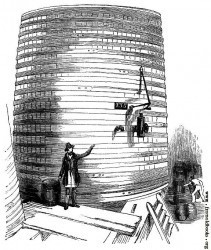
from Charles Knight, “London (Volume IV)” (1841) – digitized by fromoldbooks.org
We had the curiosity to estimate the size which a cistern would need to be in order to contain all the beer consumed by this man during these thirty-two years, and find it to be 7 feet in height and 26.6 feet in diameter. In such a cistern 201 men could be placed, each one occupying 400 square inches of standing room. If into a cistern of this size, thus filled with men, the 29,200 gallons of beer should be poured, there would be more than enough beer to fill it. In fact this amount of beer would drown 275 men, of an average weight of 156 pounds, and, owing to displacement, would, with this number of men, fill a cistern 26.8 feet deep, and 31 feet in diameter. A friend, who has seen these figures, suggests that if the 275 men were of equal capacity with the brewery workman referred to by Mr. Thomann, they would never drown, but would drink the cistern dry.
Er… an evocative image indeed. But maybe it would be better to imagine a giant quantity of beer inside a giant brewery vat or cask, instead of a cistern.

January 11, 2014
Art of Writing a Complex Sentence About Art
This abstract of this paper about art is itself a work of art, one that is difficult to describe:
“Presentational Form in First Person Research: Off-Line Collaborative Reflection Using Art,” Steven S. Taylor [pictured here], Action Research, vol. 2, no. 1, March 2004, pp. 71-88. (Thanks to Jose Closs for bringing this to our attention.) The author, who is at Worcester Polytechnic Institute, Worcester, Massachusetts, begins his report with this sentence:
“Rigorous reflection for the purposes of learning about and changing our own behavior as the foundation of an organizational change process (in the action science tradition) can include representing our tacit knowing with an artistic form and then applying explicit analytic techniques to the artistic form to generate actionable explicit knowing.”
BONUS: Art writes On the Art of Writing

Marc Abrahams's Blog
- Marc Abrahams's profile
- 14 followers



